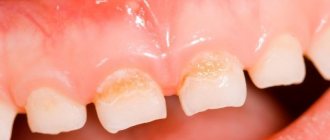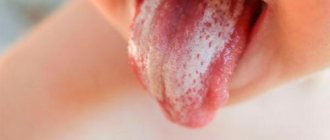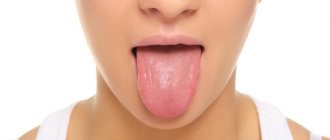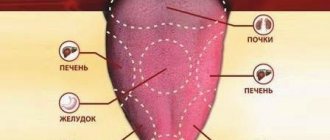Why might a yellow coating appear on a child’s tongue?
Healthy children have a translucent coating on the tongue of a loose structure. If there is a change in color or density, you should consult a specialist, because the reasons can be quite serious.
More often, the tongue indicates problems in the digestive system
Parents should be alert to the following symptoms:
- maintaining yellowness on the tongue for a long time;
- changes in plaque parameters (increase in color intensity, size of the affected area, layer thickness);
- unpleasant odor from the mouth.
More often, the tongue indicates problems in the digestive system.
Characteristic manifestations can be supplemented by poor appetite, nausea, vomiting, as well as pain in the abdominal area.
When visiting a clinic, the doctor considers the presence of yellowness as one of the symptoms of the following diseases:
- jaundice (physiological in infants, hemolytic, hepatitis);
- poisoning;
- inflammations in the oral cavity of various types (stomatitis, caries, sore throat, gingivitis, glossitis);
- infectious diseases in which there is an increase in temperature;
- severe somatic pathology (diabetes, autoimmune processes, kidney disorders, etc.).
If yellowness is detected on the surface of the child’s tongue, in addition to consulting a pediatrician, the help of other specialists will be required.
To make an accurate diagnosis, a number of studies are carried out, and only on the basis of the collected tests is the true cause of the formation of yellow plaque on the mucous membrane determined.
When should you consult a doctor?
Important! Experts recommend not to delay visiting a pediatrician if you have one or more accompanying symptoms that cause discomfort to your baby and negatively affect his mood and general condition.
You should not put off going to the pediatrician in cases where :
- the plaque lasts for five days;
- it is not possible to remove deposits with a brush or bandage;
- the child refuses milk, is capricious and cries for no reason;
- formations appear on the gums and inside of the cheeks.
Danger
There is no need to worry when your tongue turns yellow in the following cases:
- Parents should be alerted to plaque that does not go away for a long time
when staining the mucous membranes and tissues in the oral cavity after consuming products with a coloring effect;
- if oral hygiene is not maintained;
- overeating food, in particular saturated fat;
- after taking medications.
This yellowness disappears after several procedures of cleaning the teeth and the mucous membrane with a special brush.
Parents should be alerted to plaque that does not go away for a long time, especially if other symptoms characteristic of the disease also appear.
This may be increased body temperature, nausea, gag reflex, frequent attacks of heartburn, decreased appetite, and abdominal pain. In this case, it is worth paying attention to the structure of the layer and its shade.
A thick, dense coating with a large localization zone and a green or dark brown tint does not bode well.
When examining the tongue, you can pay attention to the localization of the plaque.
Each place signals disturbances in the functioning of certain organs:
- if yellowness is concentrated on the back of the tongue, there is reason to suspect problems with the intestines;
- a yellow tip indicates a heart problem;
- an uneven plaque with cracks forms on the midline due to gastritis and ulcers;
- the extreme posterior points on the tongue indicate kidney dysfunction;
- coating of the front part and along the edges indicates diseases of the respiratory system;
- when diagnosing the spleen, yellowness is noted on the right, and liver problems are read on the left side;
- plaque over the entire surface with uneven coverage is a signal of decreased immunity.
Additional Information
Sometimes plaque in the oral cavity has a mixed color - this is an important diagnostic sign that the doctor will definitely pay attention to. For example, sometimes you may notice a yellowish-green coating. This phenomenon may indicate the active proliferation of bacteria and fungi in the oral cavity (including candidiasis pathogens). Causes include liver pathologies, which are accompanied by stagnation of bile.
If the plaque has a brownish tint, it may indicate prolonged dysbacteriosis. In this case, a fairly dense layer is formed on the tongue. But a yellow-gray coating is often observed in people with long-term pathologies of the digestive tract.
Of course, you should always pay attention to the accompanying symptoms, in particular the presence of an unpleasant odor, pain, the formation of erosions and cracks.
Most common reasons
Let's look at the most common reasons for the appearance of a yellow coating on a child's tongue:
| Yellowness on a child 's tongue | ||
| Cause | Symptoms | Treatment |
| Overeating the night before | Unpleasant sensations in the stomach, heaviness, nausea, dry mouth, yellowish coating on the tongue | A gentle diet, drinking and rest are prescribed. In case of constipation, an enema is recommended. |
| Inflammatory process of the oral cavity | Plaques on the tonsils, formation of aphthae, ulcers. A pronounced yellow coating is localized at the tip of the tongue and in the middle. | Anti-inflammatory drugs are prescribed to eliminate the cause. The plaque goes away as the child recovers with the help of daily oral hygiene. |
| Infectious diseases | High body temperature, vomiting, diarrhea, bleeding cracks in the tongue and yellow-brown coating | First of all, the cause of yellowness in the tongue is eliminated. To remove plaque, it is recommended to follow generally accepted rules of hygiene: brushing your teeth and oral mucosa twice a day, rinsing the cavity after each meal. |
| Jaundice | Yellowing is observed not only on the mucous membrane, but also on the skin and whites of the eyes. In addition, weakness, lethargy, and pain in the right hypochondrium are noted. The coating forms on the mucous membrane of the tip of the tongue and its frenulum, the shade is close to lemon. | A blood test and liver biopsy are performed to determine the exact cause of the disease. Drug treatment is prescribed individually, taking into account the nature of the origin of the disease. The drugs used are: Silibor, Sirepar, Silibinin, etc. Phototherapy is also carried out, and a diet is recommended. When an obstructive form is diagnosed, surgery is prescribed. |
| Gastrointestinal disorders | Symptoms: loss of appetite, nausea, vomiting, pain in the duodenum, heartburn, bad breath. Light yellowness (white-yellow or gray-yellow coating), located in the central part of the tongue. | Conducting drug treatment using drugs: Chamomill, Dioscorea, Magnesia phosphorica, Colocynth, etc. In addition to drugs, a diet rich in minerals and vitamins is developed, and a food intake regimen is established. |
| Insufficient oral hygiene | Yellowness on the tongue, teeth and gums, plaque has a dense structure. | Daily brushing of teeth and the surface of the tongue with toothpaste using a scraper and brush, which is intended for mucous membranes. Mouth rinsing is recommended after every meal. |
| Somatic pathologies | There is intoxication, disruption of the body's metabolic functions and other symptoms characteristic of a particular disease. The tongue is covered with a yellow coating with a slightly brownish tint, localized in a dense layer over almost the entire surface of the tongue. | Patients are prescribed a medicinal course of treatment, which is supplemented by psychotherapeutic influence to regulate the mechanism of development of the disease. A diet is also being developed to strengthen the body’s immune system and saturate it with vitamins. |
Possible causes of a yellow coating on a child’s tongue
The most extensive group of infectious diseases that are characteristic of childhood is considered:
- diphtheria;
- scarlet fever;
- foot and mouth disease;
- whooping cough;
- cholera;
- dysentery, etc.
Yellowing of the oral mucosa can have a different origin; it is not possible to determine the exact cause at home, unless, of course, it is the consumption of food with a coloring effect.
You can assess the situation and prescribe treatment only by understanding why the plaque appeared, after taking tests and performing an ultrasound.
When should you be wary?
As already mentioned, a yellow coating on a child’s tongue may be associated with the nature of the diet or improper oral hygiene - in such cases, the surface of the tongue can be cleaned quite simply.
Parents should be wary if a dense layer of plaque has formed in the oral cavity, which is difficult to remove and quickly forms again. Of course, you need to pay attention to the presence of other signs. For example, if a child complains of abdominal pain, heartburn and other disorders, or if ulcers and other lesions can be noticed in the oral cavity, then you should consult a specialist.
Who should I contact if a yellow coating is found on the tongue (for a 1-year-old child, for example)? Of course, first you should show your baby to a pediatrician, who will conduct a preliminary diagnosis and give further recommendations. For example, sometimes a child must be treated by a dentist, endocrinologist, or hepatologist. All this can be found out during diagnosis.
A yellow tongue, in combination with other symptoms, makes it possible to differentiate the disease that caused the plaque. In some cases, parents need to take urgent measures for correct diagnosis and timely initiation of treatment.
In a bottle-fed baby, the appearance of yellowness on the tongue may mean that the formula is not suitable for the baby. After consulting with your pediatrician and taking tests if necessary, you should choose a different diet for your baby.
If a change in the color of the tongue is accompanied by yellowing of the skin, sclera of the eyes, poor health, discoloration of stool, darkening of urine, the source of symptoms is the liver. Jaundice can be infectious, physiological or mechanical in nature. The appearance of these signs is a good enough reason to see a doctor and undergo an examination.
Infectious jaundice leads to unpleasant complications that will have to be dealt with for a long time. Mechanical can be a consequence of the appearance of neoplasms, and physiological often goes away over time without treatment.
Sometimes symptoms of jaundice appear when there is an excess of carotene in the body due to excessive consumption of it in food. Excluding products containing it from the menu will normalize the color of fabrics, but this takes time. You should not diagnose your child yourself - this could lead to a truly dangerous disease being missed.
Diagnostics
If a child has noticed a change in the color of the mucous membrane on the tongue, it is necessary to first exclude everyday incidents that led to this effect.
If a child has noticed a change in the color of the mucous membrane on the tongue, it is necessary to first exclude everyday incidents that led to such an effect.
It is impossible to eliminate dangerous situations on your own, so it is recommended to contact your local pediatrician.
After the examination, you may need to consult a dentist or gastroenterologist.
If severe somatic pathologies are detected, the child is referred to a specialized specialist (endocrinologist, hepatologist, nephrologist, hematologist).
To confirm or refute a preliminary diagnosis, it is necessary to conduct a number of studies:
- blood, stool and urine tests;
- a detailed biochemical blood test (for the level of glucose, bilirubin, ALT, AST, creatinine, urea, etc.);
- Ultrasound of organs involved in the functioning of the digestive system, and, if necessary, the abdominal cavity;
- esophagogastroduodenoscopy.
Vegetables and fruits that are yellow can cause your tongue to turn yellow.
Treatment
There is no need to treat yellow plaque without eliminating the causes that caused this effect. Therefore, after examination by a doctor (or several specialists), the patient is prescribed medication.
Since most of the causes are associated with disruption of the digestive system, in particular the correct outflow of bile, a series of studies are prescribed, based on the results of which treatment tactics are developed.
Therapeutic therapy is carried out in inpatient and outpatient settings. This issue can only be resolved by a specialist. In addition to medications, a dietary diet is recommended, including lean protein and vegetable foods.
Therapy is often enhanced with phototherapy, sanatorium treatment, and folk methods involving the use of decoctions based on medicinal herbs.
The following components are considered the most effective:
- bee products (propolis, honey);
- a decoction of sage and chamomile for rinsing the mouth;
- eating coarsely chopped vegetables (hard structure removes plaque).
Preventive measures
Measures to prevent the formation of yellowness on the tongue include the following recommendations:
- Daily oral hygiene will help avoid the appearance of unwanted plaque on the tongue.
Clean your teeth and oral cavity every day with a special scraper;
- Minimize consumption of products containing artificial or natural dyes;
- balance your diet by adding only healthy foods;
- minimize the consumption of carbonated drinks, black tea, coffee (although such drinks are generally not recommended for children);
- do not include smoked and fried dishes in the menu;
- do not overeat while eating;
- Regularly treat dishes and nipples for infants at high temperatures to kill bacteria.
Yellow coating on the tongue of a baby
The discovery of a yellow coating on the tongue of a baby should alert parents. This symptom often indicates a problem in the body. The location of a dense layer on the back part indicates jaundice, and if localized in the left half in the middle, suspicions fall on the liver.
One of the main reasons for discoloration of the oral mucosa of an infant is the accumulation of bacteria. The main number of them accumulates at the root of the tongue.
This localization is explained simply - during feeding, the front part is involved, while the back remains motionless, which eliminates its cleansing. It is easy to prevent the development of bacteriosis by following daily hygiene procedures.
But in any case, it is better to consult a doctor about yellowness so as not to waste precious time.
Signs of newborn jaundice
In a teenager
For a teenager, in addition to the reasons listed, there is another one related to the transition period. The growing up of boys and girls at this stage is accompanied by a hormonal surge. This effect does not have the best effect on the functionality of internal organs.
If the formation and outflow of bile is disrupted, yellowing of the tongue is observed. This symptom does not require treatment; it is enough to manage with hygiene procedures.
Based on the information presented, it should be noted that yellowness on the tongue should at least alert you. You should not rely on chance and wait until the problem disappears on its own. The child’s body is not yet strong enough to cope without the help of specialists.
Types of stomatitis
The treatment regimen for stomatitis in children is based on the type of disease. There are several types of stomatitis:
- bacterial;
- viral, including herpes;
- fungal;
- aphthous;
- angular;
- allergic;
- traumatic.
All types of stomatitis occur in children, but the most common among children under 3 years of age are aphthous, candidal, herpetic and allergic. An increase in the incidence of traumatic stomatitis is usually associated with a period of active growth of primary teeth.
It is important to understand that in some cases, stomatitis is combined with other diseases with similar symptoms and is the first sign of more serious diseases. For example, with cheilitis - inflammation of the mucous membrane and red border of the lips, food allergies, etc.










